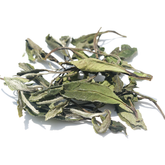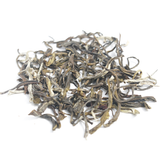Chinese Tea Isn’t Just a Tea Bag: Loose Leaf, Flavored Tea, and Cultural Differences
In 2024, the global tea bag consumption is estimated to reach around 145 billion tea bags per year, which equals about 3.97 billion tea bags consumed every day. When you think of tea, what probably comes to mind is a quick and convenient tea bag, or a cup of flavored tea with added milk, sugar, or artificial flavors. In most Western supermarkets, tea usually means tea bags, and drinking tea is often considered something fast, simple, and casual.

In our previous article, What Is Tea? , we learned that all real tea comes from the same incredible plant: Camellia sinensis , while China often uses "cha" to refer to this beverage? It's not just a difference in pronunciation; in fact, there are many distinctions between the tea most Chinese people drink daily and what most Westerners understand as tea.
The word "TEA" (and similar pronunciations like "té" in Spanish) is deeply connected to historical tea trade. It originated from the Amoy dialect (a dialect spoken in China's Fujian province), where the local pronunciation for tea sounded similar to "Tea." When 17th-century European traders, especially the Dutch, began importing tea leaves by sea from ports like Xiamen, they adopted this local Chinese pronunciation. This is why we use the word "tea" today.(Further Reading:How to Say It in Chinese)
The emergence of What Is Tea Bag? largely stems from this maritime trade and subsequent industrialization. They are designed for mass production and standardization, typically containing low-cost broken tea leaves or flavored teas. This significantly reduces tea costs. Because tea leaves are often machine-picked for tea bags, the raw material consists of these smaller, broken pieces. This model prioritizes convenience and uniformity but often sacrifices the tea's natural quality and flavor. Furthermore, broken tea leaves are much more prone to becoming bitter during brewing.

In stark contrast is "CHA" (Chinese tea). The core of Chinese tea lies in its pure, natural, and handcrafted essence. Chinese loose leaf tea is typically hand-picked, resulting in whole, unbroken tea leaves that offer a more complete flavor profile and are less likely to become bitter. The quality of Chinese tea is profoundly influenced by its terroir—the unique regional conditions where it grows. The flavor and quality can vary drastically from one single tea garden to another. This traditional approach focuses on the inherent qualities of the tea leaf itself, enhanced by the exquisite craftsmanship of the tea master.
Flavored Tea vs. Loose Leaf Tea
When you walk through a supermarket or visit a coffee shop, you’ll often see a wide variety of teas. Some are packed with strong fruity aromas, while others are simply pure tea leaves. These generally fall into two main categories: flavored tea and loose leaf tea, and their differences go far beyond just taste.

As the name suggests, flavored tea is made by adding artificial flavors, fruit pieces, flower petals, or spices to the tea leaves. The purpose is to appeal to a wider range of tastes and to create unique and usually strong aromas that cover up the natural bitterness of broken tea leaves or low-grade tea. For example, the Earl Grey tea you often drink (which contains bergamot oil) or various fruit teas fall into this category. Flavored teas often smell very strong, but when brewed, the tea soup usually lacks a noticeable aroma.

These flavored teas are typically made with tea dust, broken tea, or lower-grade tea leaves, and their flavors mostly come from added ingredients rather than the tea itself. From a health perspective, flavored tea sometimes contains added sugars or artificial flavorings, which may carry unknown health risks if consumed regularly over time.
On the other hand, Chinese loose leaf tea is completely different. It refers to pure, natural tea leaves without any added ingredients. Its flavor comes entirely from the tea plant itself and its unique traditional processing methods. Loose leaf tea is rich in natural tea polyphenols, amino acids, vitamins, and other beneficial compounds. These natural elements not only give the tea its unique aroma and complex taste but also bring a range of well-known health benefits.
In the Chinese market, people who truly love tea almost never drink flavored tea. They always prefer to drink authentic loose leaf tea.
Why We Recommend Loose Leaf Tea
After learning about the differences between loose leaf tea and tea bags, you might be wondering: Why are more and more people recommending Chinese loose leaf tea? The reason is simple: it offers a far superior tea drinking experience and a healthier way to enjoy your brew.

First off, when it comes to aroma and flavor, loose leaf tea has an unmatched advantage over tea bags. When steeped in hot water, whole loose tea leaves fully unfurl, slowly and consistently releasing a wealth of aromatic compounds. This means you'll experience a more lasting burst of aroma and a richer, more complex flavor profile. This is why Chinese oolong teas, for example, boast such an incredible variety of fragrant notes. In contrast, the broken bits of tea in a tea bagquickly release a rush of bitter compounds (like theaflavins), often resulting in a harsh-tasting brew with a flat aroma. With loose leaf tea, you truly get to taste the authentic flavor and lingering sweetness (known as "hui gan") of the tea.

Secondly, loose leaf tea is generally healthier. Whole tea leaves better preserve the rich natural compounds found in the tea plant, such as polyphenols, amino acids, vitamins, and minerals. These natural components not only give the tea its unique flavor but also contribute to numerous health benefits.
Finally, you might be curious about caffeine intake. Interestingly, loose leaf tea generally allows for better control over caffeine release. While broken tea in bags might have similar caffeine content, its larger surface area means caffeine extracts faster and more intensely, leading to a higher immediate intake. Loose leaf tea, however, releases caffeine more slowly and evenly. You can even adjust the steeping time to control the caffeine concentration, allowing for a gentler stimulating effect that avoids the potential over-stimulation some experience with tea bags. Choosing loose leaf teameans opting for a purer, healthier, and more controlled tea experience.
Conclusion & What's Next
Congratulations! You've now uncovered the key differences between "CHA" and "TEA." While "TEA" often refers to standardized, industrially produced tea bags, "CHA" represents a natural, ecologically crafted, and hand-picked teaproduct. We've seen how loose leaf tea offers superior flavor, richer aromas, potential health benefits, and even better value compared to tea bags.

Ready to dive deeper into the fascinating world of Chinese tea? In our next article, we'll explore " The Six Types of Chinese Tea." Get ready to learn about each category's unique characteristics and discover their distinct flavors.





